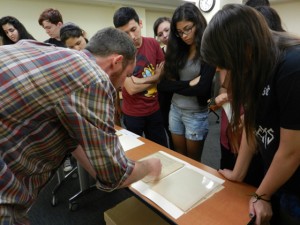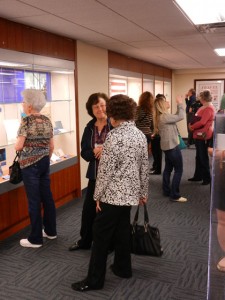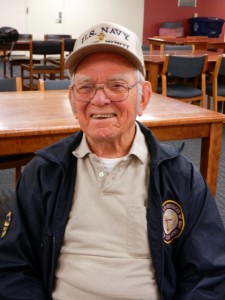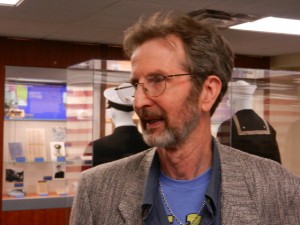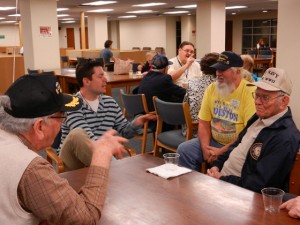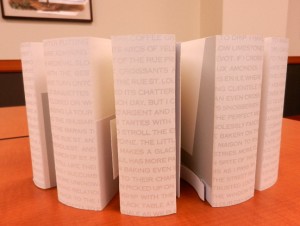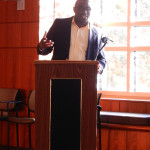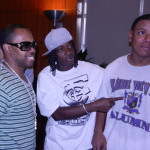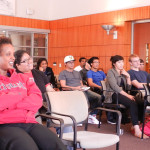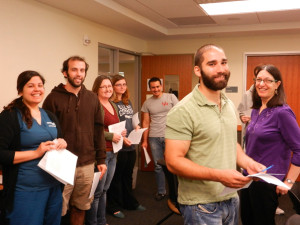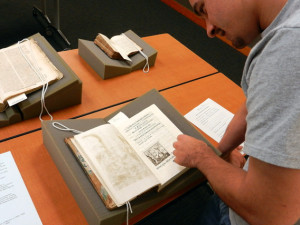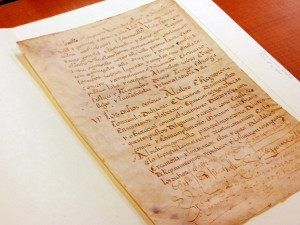
Some high school students spend their summer vacations soaking up the sun or playing computer games. But Houston-area students enrolled in the Wonderworks academic enrichment program spend five weeks of their summer intensively studying art, architecture, film, or literature. In early July, Wonderworks students in a class called Story Lines visited Special Collections to get up close and personal with one of author Larry McMurtry’s manuscripts.
The students had already read McMurtry’s novel The Last Picture Show, a coming-of-age story set in a small Texas town, and viewed the classic film of the same name. But their instructors Zachary Martin and Daniel Wallace, PhD students in the Creative Writing Program at the University of Houston, also wanted them to see first-hand the process McMurtry used in shaping his novel.
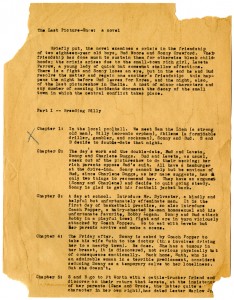
Larry McMurtry’s typed notes and outline for The Last Picture Show (from the Larry McMurtry Papers)
Students examined the original typewritten first draft, noting McMurtry’s handwritten word changes and replacements of characters’ names. (Would the beautiful Jaycee have been as alluring if she were still named Lavetta?) Martin led the class through a typed outline of the plot points McMurtry originally intended his story to follow, encouraging them to identify which ones stayed in the novel and which ones were discarded by the author.
Martin used McMurtry’s draft as a springboard to talk to the students about their own writing, and the necessity of building up their prose and ruthlessly editing it into something stronger. Perhaps viewing the original words of one Houston-related writer has inspired the next generation of Houston writers.
To be inspired yourself, please visit the Special Collections reading room Our summer hours are Monday – Friday, 9:00 a.m. to 5:00 p.m.
On Friday, March 14th, the UH Libraries hosted a reception for members of the USS Houston Survivors Association and the Next Generations, who were visiting Houston for their annual reunion. The organization was established in 1946 to bring together surviving crew members of the heavy cruiser USS Houston (CA-30), who had fought together in the Battle of the Java Sea, and spent 3 1/2 years together as prisoners of war. In 1981, the Survivors Association donated to the Libraries a set of historic documents, letters, photographs, and memorabilia which became known as the Cruiser Houston Collection.
In attendance this year were survivors Bill Ingram and Howard Brooks. Ingram was the second youngest crew member on the ship, having enlisted in the Navy at seventeen. Many family members of other Houston crew members were also present, as well as historian Don Kehn, author of A Blue Sea of Blood: Deciphering the Mysterious Fate of the USS Edsall. The group enjoyed the opportunity to view the USS Houston Exhibition, have some cake and lemonade, and relax in the camaraderie of longtime friends.
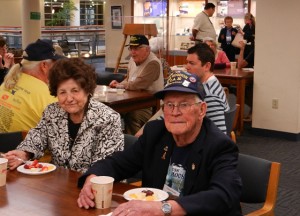
Teresa Reilly, widow of John D. Reilly, with Howard Brooks, former crew member of the USS Houston (CA-30)
UH Special Collections wishes Howard Brooks a speedy recovery after his recent fall.
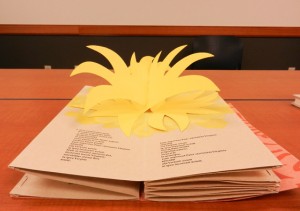
Sanctae Hildegardis Circulus Sapientiae =: Circle of Wisdom by Claire Van Vliet and others for Janus Press.
Among our visitors to Special Collections are students from the School of Art, who are particularly interested in the design and structure of books. These students enjoy exploring our collections of fine press books and artists’ books.
Fine press books are created with a strong emphasis on design and materials. They often involve a collaboration between a writer, printer, and visual artist. The books are usually printed on handmade paper with a carefully selected typeface using an old-fashioned letterpress printer. Visual harmony exists between the text, the illustrations, and the binding. Fine press books are highly sought by collectors and libraries.
Artists’ books explore the line between a book and a work of art. Less traditional than fine press books, they often have unusual bindings resembling structures such as an accordion, a tunnel, or a star. Although they are usually made from paper, artists’ books may be constructed with wood, plastic, or even rock. Artists’ books are often as whimsical as they are beautiful, and may be found in libraries, museums, and private collections.
Both fine press books and artists’ books are usually published in small runs by independent presses.
Special Collections holds numerous books from the following fine press printers. These books can be located in the UH Libraries’ catalog by typing the name of the press in the Author field or following the links below.
Artists’ books may be located in the UH Libraries’ catalog by entering the subject heading Artists’ books. The subgenre known as pop-up books may be located by entering the subject heading Toy and movable books — Specimens.
Special Collections is particularly strong in artists’ books from the following presses and artists’ collectives.
Peter & Donna Thomas or Thomas Peter (Peter R.)
Art students or those who are simply curious may wish to view artists’ books by structure. Special Collections holds the following examples of particular book structures:
Accordion Binding
Barton, Carol J. Loom. Bethesda, Md.?: Carol June Barton?, 1989.
King, Ronald. Hick, Hack, Hock. London: Circle Press, 1995.
Rowe, Sandra. Snake. Rosendale, N.Y.: Women’s Studio Workshop, 1991.
Pop-Up Book
Hildegard, Vliet C. Van, Katie MacGregor, Robert Mealy, and Na’ama Lion. Sanctae Hildegardis Circulus Sapientiae =: Circle of Wisdom. Newark, Vt: Janus Press, 2001.
Tunnel Book
Barton, Carol J. Tunnel Map. Bethesda, Md: C.J. Barton, 1988.
Sculptural Book
Hom, Mei-ling. In the Morning. Rosendale, N.Y: Women’s Studio Workshop, 1990.
Jacob’s Ladder
Morrison, Lois. Water/fish. Rosendale, N.Y.: Women’s Studio Workshop, 1988.
Please visit us in Special Collections the next time you’re feeling arty!
An engaging talk by author Maco Faniel plus a showing of Houston hip hop pioneers made for an enjoyable evening hosted by the University of Houston Bookstore and the UH Libraries. The event, a book talk and signing for Hip-Hop in Houston: The Origin and The Legacy on History Press, drew a crowd of students, librarians, and hip hop artists to the Honors Commons in M.D. Anderson Library on October 17th. The event also served to announce the donations of the DJ Steve Fournier Papers and the Carlos “DJ Styles” Garza Papers to Special Collections, where they will become part of the Houston Hip Hop collecting area.
- Faniel, currently a PhD student at Rutgers University, spoke eloquently about the significance of Houston as a center for hip hop.
- DJ Steve Fournier, founder of the Rap Pool of America, recounted his struggles to play hip hop in local clubs.
- Carlos Garza, better known as DJ Styles, was both a club DJ and producer for the Odd Squad and Devin the Dude.
- DJ Lil’ Randy of the Screwed Up Click, DJ Wickett Crickett – one of the first to bring hip hop to Houston, and poet Se7en.
- The audience enjoyed a lively book talk and Q&A with author Maco Faniel.
- DJ and rapper Icey Hott, of classic Houston group Street Military, with blogger Jonathan Scroggins of A Day and a Dream
Students from Dr. Susan Kellogg’s course “Researching Mexican History” visited Special Collections this week to learn about conducting research with rare books and archival materials. This course designed for History majors teaches undergraduates to do research using both traditional and digital sources, applying these skills to historical materials related to Mexico.
In the Evans Room, Special Collections’ classroom, students viewed items that dated from the 16th century to the 20th century, such as books, maps, letters, and newspapers. Archival highlights included a letter written by Mexican President Antonio Lopez de Santa Anna in 1833 and a ledger kept by Leonor Villegas de Magnón for her medical organization Cruz Blanca during the Mexican Revolution. All of the archival materials on display were drawn from our Hispanic Collections.
After examining all of the materials, each student selected an item to study more closely, learning to apply the kinds of questions asked by historians to a unique or rare item. Class discussion centered around the intended audience for the work, contextual information that might help historians to interpret items more successfully, and what types of research questions might be prompted by a particular item.
Working directly with rare and archival materials gives students an opportunity to better understand the process by which scholars interpret raw source material to create new knowledge. Faculty members who wish to schedule a class visit to Special Collections can contact Coordinator for Digital Projects and Instruction Julie Grob at jgrob@uh.edu. Special Collections materials are also available to all students for individual study in our Reading Room with the presentation of a photo ID.
